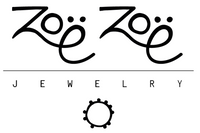There are many different techniques used in the world of metal jewelry, but most of them can be divided into two main categories: Hand fabricated, or Cast jewelry.
Most people don't know the difference or how to distinguish the two, but this is an important concept for jewelry lovers to grasp because it impacts the durability of the finished piece.
In this article, I am going to explain the difference between the two approaches, the pros and cons of each side, and why I make exclusively hand fabricated jewelry even though it is a much slower process.
How jewelry is born...

left: silver being brought into it's liquid state
right:being poured into an ingot mould
All jewelry begins by melting the metal into it's liquid state.
With hand-fabricated jewelry, the liquid metal is poured into a simple rectangular mould to create an "ingot", which is basically a metal blob that will later be stretched into sheet or wire.
On the other hand, with cast jewelry, a precise mould in the shape of a finished piece of jewelry is used. The liquid metal is poured directly into the mould, and when the metal solidifies, you are left with a nearly finished piece of jewelry.

White and yellow gold ingot.
Hand Fabricated Jewelry
In hand fabricated jewelry, the ingot is rolled, pulled, hammered, and bent into a shape until a jewel finally comes to life.
All of that pounding and bending significantly compresses the molecules, of the metal, pushing the air out, and making the metal "work hardened". Hand fabricated jewelry is nearly 50% harder than cast jewelry. That extra hardness means that the final jewel has a higher density and durability to its cast counterparts.
Hand-fabricated is the only method in which a piece is handmade from scratch by a skilled craftsperson. It is becoming less and less common as casting technologies have advanced in recent years.
 Hammering a ring round.
Hammering a ring round.
Pros:
- Nearly 50% harder & tougher than cast jewelry
- Each piece of jewelry is individually hand-crafted. Even when the same design is replicated, its handcrafted nature will make it unique in one way or another.
- You can go for thinner, more minimalist designs that would be very weak if created with casting.
- Completely and truly handmade from scratch with a high level of craftsmanship
Cons:
- More time-consuming and labor-intensive to create, and therefore is usually more expensive than cast jewelry.
Cast Jewelry:
On the other hand, when jewelry is cast, we are left with the finished shape of a piece of jewelry as soon as it solidifies from casting. The result is "rough around the edges", so there is finishing work to be done on the piece like sanding, polishing, and stone setting, but the fabrication/building stage of creation is essentially skipped.

production of wax models being prepared for casting (stock image)
But wait...remember the porosity I mentioned earlier?
Since all of that pounding and stretching of the metal is not involved in the casting process, all the little balls of air stay trapped in the jewel, making the metal weaker and more susceptible to denting, bending out of shape, and even breaking, because the metal itself is still going to be very malleable and soft.
If you are going for a chunky, solid piece of jewelry, a cast piece is likely to stand the test of time, but cast jewelry on the thin or minimalist side, cannot be considered heirloom quality. Especially for jewelry that get worn often or get lots of wear and tear like rings and bracelets.
This is the way that the vast majority of jewelry is made in modern day. I would estimate that at least 95% of metal jewelry on the market is cast. Jewelry produced in large quantities by major brands is 100% through casting, although the technique is used by businesses of all sizes.
In more recent years, CAD (Computer Aided Design) has completely revolutionised the jewelry world. Traditionally, the wax models are crafted by highly skilled wax carver, but CAD allows you to design these moulds directly on the computer, removing the need for a skilled craftsperson all together.
Pros:
- Is a very efficient method to create exact replicas of the same piece of jewelry in mass quantities.
- Quicker production time can lead to more affordable jewelry.
Cons:
- Makes weaker jewelry that is more prone to warping and breaking.
- Not suitable for dainty, minimalist designs
- You cannot create mixed metal designs like silver and gold or mixed golds.
Hybrids:
I thought it was worthy to mention that some jewelry uses a combination of both techniques.
For example, a jeweler that casts a ring but solders on prongs by hand is taking an extra step to make the weakest part of the jewel stronger than if it were fully cast.
My personal take...
Up until here, I've been sticking to the facts. But now I want to share with you why I have made it my choice to create exclusively hand-fabricated jewelry.
In my workshop, hammering, sawing, soldering, and filing each piece individually is what breathes soul into it, and what makes it an art piece instead of a production piece.
The difference between a hand fabricated jewel and a cast jewel can be perfectly paralleled to the difference between an original painting and a print.
Having had the opportunity to learn from generational masters of goldsmithing, I feel proud to be carrying on an ancient tradition that is quickly being wiped out by modern technology.
Yes, the techniques I use are slow, but that slower rhythm of making is what gives me time to consider every detail, and truly have a conversation with the metal as the piece unfolds.


2 comments
Zen vs TV evangelism
Zen vs TV evangelism